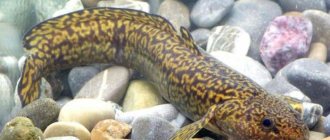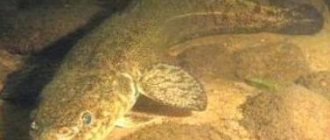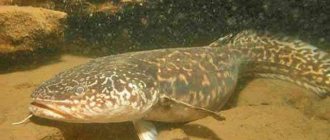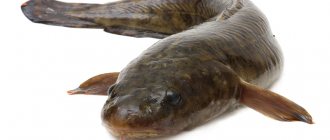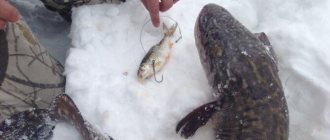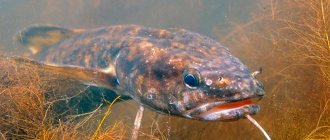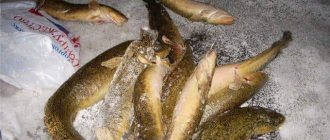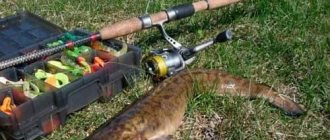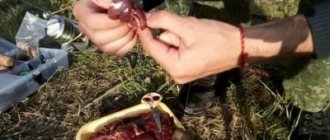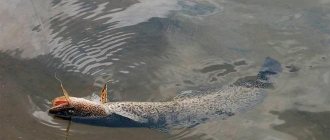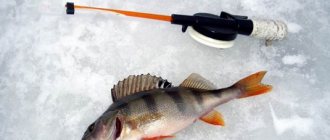Jigs for burbot, along with spoons and jigs, are successfully used for ice fishing for this fish wherever it is present. In this article we will analyze the features of this artificial bait, selection criteria and rules for fishing with it. These analogues of conventional baits differ from standard ones in their larger size and weight. This is connected, of course, with the peculiarities of burbot fishing.
Tackle for jig fishing
Tackle for catching burbot in winter with a jig should be strong and rigid. For this fishing, you can use a store-bought hard fishing rod for winter trolling. A nod is not needed - the predator’s blow is well felt in the hand. Siberian fishermen simply use a wooden block with two wires (nails) for the reel and a ring at the end for passing the fishing line. The fishing line used is strong and thick. Burbot is not a shy fish. The main thing in fishing for it is to find a parking spot or trail. If the search is successful, he will take almost any gear that the fisherman offers him.
Classic jig for burbot
Once upon a time, catching burbot using artificial bait was very common.
In Sabaneev’s time, these were crude and primitive homemade spoons. If we take into account that at that time there was a lot of a wide variety of fish, then it is quite possible to admit the advisability of fishing with spoons. Nowadays there are fewer and fewer such amateurs, but the practice is to combine fishing with fixed jigs and set baits with more sportive fishing, where in addition to spinners, heavy jigs and jigs are used.
If we talk about artificial baits, then popular gliding spoons are not suitable for catching burbot. You will need heavy and narrow spoons without arching, which play similar to the game of a perch “nail”, but twice as large as the last one. You should also change the game of the spinner itself. Here you will no longer need to swing the bait 30-40 cm from the bottom with a fishing rod and pause in the lower position. The game that attracts burbot consists of tapping the spoon on the bottom, raising silt and turbidity with this fuss, in small and smooth vibrations of the spoon at the very bottom, sometimes touching it and again making a fuss in the mud cushion or on the sand of the rift.
It should also be taken into account that in our time it is difficult to seduce a predator with a naked lure, no matter how well it plays. Pike perch, bersh, and now burbot, spoiled by fishermen, prefer bait with the addition of the tail of a white fish or a whole small ruff, sprat, bleak, and verkhovka. Burbot, of course, is a lover of the snotty ruff, and it is not at all necessary to cut off the spines of the ruff.
Bersh - description, fishing secrets, habitats
Pike perch - description of fish, photos, fishing, spawning, habitats
Burbot - description and catching, photos, sizes, periods of activity
Large “lobes” of worms or bunches of bloodworms are also attached to spoons, heavy jigs and jigs.
As for playing jigs and jigs, a different principle is required here too.
Fractional and frequent vibrations are unacceptable to cause a burbot's grip. Here, a smooth game at the bottom with tapping and dragging the jig along the bottom is more suitable. This is achieved by releasing the jig with the flow and pulling it back. It is clear that the weight of the jig must be selected for this effective fishing technique.
Catching burbot with a jig
When catching burbot with a jig in winter, it is important to realize that this is a special kind of fishing. It is different from the way we are used to catching other fish. This difference is due to the biological characteristics of the fish. This predator loves cold, night, bad weather and its permanent habitat. Therefore, you can successfully catch it in winter, at night, in cloudy weather and at a certain point or trail. You won’t find this fish in other places, as it lives sedentary in its campsites. These features are detailed here:
What to fish with
Most often, burbot is caught on bottom fishing rods, with a jig or spoon. When fishing passively, girders are often used, and quite effectively. But the main gear is still a fishing rod with a spoon or jig.
It is best for burbot to take on white spoons, the size of which is similar to the fish that it usually feeds on at this time. And these are usually pipe cleaners, about 7cm long. And since all the other fish in the reservoir are sluggish, the burbot is used to seeing them like this, then the game of the spoon should not be active, make the game smoother. You should also not raise the spoon higher than 30 cm from the bottom; it should be located directly above the bottom, since burbot feeds exclusively in the bottom layers. It’s also worth twitching the lure periodically. When the spinner takes a horizontal position for a certain period of time, the likelihood of a burbot biting increases.
Unlike other predators, the burbot bite is smooth, more like a hook. His hook should be short but strong. Burbot often grabs the spoon across, which leads to its derailment.
You can successfully catch burbot using a jig. A large pike-perch jig works well, but you shouldn’t get carried away with large sizes either. It’s worth remembering that the smaller the jig, the more often the bite. Burbot bites on an empty jig very rarely, so you need to attach additional bait to its hooks. This could be small fish, pieces of fish or worms. Better than others, burbot takes a jig with a fry on the hook, but the tail of a gudgeon or ruff also works effectively.
Live bait is also an excellent bait for catching burbot. Usually, girders are used for live bait fishing, as mentioned above. The traps are installed in the evening and checked for catch in the morning. It’s better to play it safe when fishing like this and use a leash. It happens that instead of the expected bite of burbot, pike perch or pike take live bait, but if the pike perch cannot cause any harm to the tackle, then the pike will easily cut the line with its sharp teeth.
It is best to use a brush as a live bait, and if this is not possible, then, in principle, you can use any live bait, giving preference to fry caught in the same reservoir.
Find out what you need to catch big fish
Bait for burbot jig
To catch this predator on a jig hook, you need to attach a bait. It is best if it is fish or fish slices. You can also pour a bucket of water into the hole with mixed animal remains - blood, fish, minced meat, liver. Accordingly, this should be done only in the burbot habitat, when it has already been found. In those points of the reservoir that this fish never visits, it will not even be suitable for bait.
The favorite baitfish for burbot is loach. The whole fish is attached to the hook either as live bait or in pieces. But the loach is difficult to get in winter. Therefore, perches, ruffs, gobies, and minnows are more often used.
There is an opinion that burbot prefers bottom fish. But it is also well known that it takes well on fresh cuts of whitefish, vendace, carp and any other whitefish. Fresh cutting is important - in this case, the blood of the fish will get into the water. The smell from these pieces distributed in the water will arouse additional interest of the predator. Burbot sees poorly from a distance, but has an excellent sense of smell and hearing. This factor must be used when fishing. If there is an active bite, then you can use almost any animal bait - liver, shrimp, capelin, sprat. If the predator is not very active, then, of course, it is better to bait the hook with a fresh piece of his favorite fish so that he cannot resist such a treat.
When attaching bait to a hook, the sting must be left open and clean from all kinds of debris, this will protect the fisherman from offensive incidents.
The right jig for burbot
Catching burbot with a jig is done “by knocking”. This fish is very attracted to the sound of the bait hitting the bottom, as well as the turbidity raised from this process. Along with special jigs or spoons, using jigs for burbot is very effective. In addition, this predator has a huge mouth; it requires the use of large bait, at least the size of a walnut. In winter, you should catch burbot using a jig using the sound. The details of such fishing are presented in a special article:
https://podlednik.ru/lovlya_zimoj/khishhniki/lovlya-nalima-zimoj-na-stukalku
These features impose requirements for the correct bait:
- Large weight and size
- Large strong hook
- The bait must be designed so that when it falls to the bottom it will definitely hit it, despite the large bait on the hook
- It is advisable that the jig be equipped with additional sound baits - balls, petals, etc.
The jig is smaller than a winter spinner, but, unlike a vertical jig, it has a different method of attachment. The correct jig for burbot, after being tied to the fishing line, should hang horizontally, parallel to the bottom. This position will allow it, when falling to the bottom, to fall on its side and hit the bottom, even if there is a large piece of fish on the hook.
Variant of jigs for burbot
“My jigs for burbot” or “What to use to catch burbot in winter.”
Hello everyone!
At the request of Oleg Kuts, I present to your attention a short review of the baits with which I catch burbot. We have already talked about burbot, its taste preferences, hunting method and lifestyle - Winter burbot fishing
there is no point in repeating. Anyone who wants to refresh their memory can always refer to the database of our resource.
I’ll say right away that the review and opinion on the catchability of baits is only mine! The fishing method, shape, weight and size of baits may not fundamentally coincide with someone’s experience, but one way or another, they asked me, I show exactly what I use to catch burbot.
In the photo below are the baits that are used most often.
As you can see, most of them are light-accumulating.
Despite the fact that we all know about the unique vision of burbot, I believe that an additional irritant will not be superfluous, and a bait that emits light in complete darkness, in my humble opinion, is visible much further, and therefore is capable of attracting burbot with longer distances. Although, it is possible that the light may alert the burbot and an attack may not follow, so it makes sense to put a couple of fishing rods with different baits. For example, one with a “larva”, the second with a “seed”. (by the way, there are days when the double-crown “seed” whips out the phosphorus jig).
I don’t know why, but phosphorus “larvae” have proven themselves to be excellent for me, and when fishing with two fishing rods, I saturate only one jig with light (the reason for this approach is justified in the last paragraph).
As you noticed, the “larva” is mounted on a separate leash with a branch (phosphorus drop), this is done because sometimes burbot is reluctant to take a heavy jig, but at the same time eats the leash dangling in the bottom layer.
Here's another jig -
"Dolphin" 7 grams. Helps out when the floodgates are closed and the river turns into an almost stagnant body of water. A series of 4 - 6 hits on the bottom... - bleeding off 20 centimeters of fishing line, after which the light jig crawled very slowly along the bottom and only the nod began to stop, taking on a working position... bending... Did you see!? Here you go, here you go -
Different weights, different shapes and different sizes of jigs are simply necessary to have in your arsenal. You never know what the current will be on our regulated rivers, just like you never know how the burbot will behave. Today give him the bait, and tomorrow there will be a clear knock and vertical hang of the bait, without dragging along the bottom.
So, you have to be prepared for anything, that’s why I carry this amount of bait with me -
because we don’t live on burbot alone, we need to have everything at hand for any species of fish and the conditions offered by the river.
Thank you for your attention, everyone NHNCH!
Search for points and fishing spots
As we have already said, to successfully catch burbot, you need to find its trails and stopping places. Burbot loves a rocky, pebble-sandy bottom with shelter. It often stands in holes, next to which there are strandings. Large stones at the bottom, sandy or stone slopes, mouths of rivers and streams, holes under a steep bank attract it. It can live in its favorite place for years, and it is important for the fisherman to find this point.
Places to search on the river
Trails are the routes by which burbot travel to hunt at night. These routes leave the parking point, pass through places interesting for burbot and return again to the habitat of the predator. The trails can be several hundred meters long; burbot travels around them once at night.
And if a fisherman finds a path, he should not stop, but continue searching: after all, this means that somewhere nearby there is a parking lot that can house a huge number of these fish.
Choosing the right jig
You can find burbot jigs on sale. It is important to pay attention to the hook - on store-bought baits it is usually small and weak. It is best to buy jigs made of non-ferrous metals, bronze or brass; they are the ones that sound better at the bottom when hitting rocks. You can start with lead cones, which are easy to find in any fishing store or you can make yourself. A standard jig head is also suitable as a jig for burbot in winter. The weight is selected depending on the current and the size of the expected trophies. It is better to use a medium-sized jig with a relatively large hook. Experienced anglers note that a white jig head works better. Burbot are attracted by the faint glow from the phosphorus eyes on the jig head; these can also be found on sale.
Lead cones
Homemade Mormobles
Homemade cones
White painted summer jig head
You can often find so-called jig jigs. These jigs are called that because they have the size and weight of a really small jig head. Such baits are also very good for catching burbot by tapping.
Jig jig
The best option is super-heavy hand-made bronze jigs. Such baits can be found online from craftsmen who do this.
Handmade bronze bait
Subscribe to the channel:
My YouTube channel RYBAFAN on fishing:
We're OK
Burbot on jig and jig
Burbot on jig and jig in winter
It’s not for nothing that burbot has taken one of the most honorable places in the folk epic, and if a fisherman suddenly manages to pull a burbot ashore, it’s good luck. Especially if the fishing process takes place in winter from a hole, and the fishing process itself takes place with the direct participation of the fisherman.
It’s no secret that the main gear for catching burbot in autumn and winter is a donka. By the way, fishing with donks also has its advantages and charms. But fishing for burbot using the active method (using a spoon or jig), in my opinion, is one of the most interesting fishing activities, and the technique itself is quite simple and understandable even for novice burbot fishermen. It is enough to spend a couple of hours reading textbooks and studying the lifestyle of this fish to understand that it is in winter that you can get real pleasure from fishing for burbot. It is interesting that in winter burbot can be caught both day and night, and in different regions of the country the time and daily biting period may vary. One of the advantages of catching burbot with a jig (or spoon) is that the fisherman is constantly on the move, studying the body of water, tapping the bottom, while simultaneously receiving valuable information about the body of water. In addition, I personally am interested in fishing when the picture around me and the situation periodically changes - catching burbot from a hole just involves such a change, you need to walk hundreds of meters and drill a couple of dozen holes in order to find burbot and stay with the catch. That's the beauty of it.
It is also interesting that playing with a burbot jig has its own characteristics. This is a completely different type of fishing.
Firstly, a jig for burbot is, roughly speaking, a jig head on which you can attach a piece of fish, or better yet, a bunch of worms. Secondly, I noticed that burbot goes better with light-colored jigs; I paint my sinkers light gray, white or yellowish. Thirdly, playing with a jig is strictly at the bottom (I don’t raise the jig higher than 10-15 centimeters from the bottom), you have to take long pauses (up to 20-30 seconds), drag the jig along the bottom, just knock it on the bottom. At the same time, the more turbidity is formed around the jig, the better.
As for the weight of the jig itself, the situation is ambiguous: in my arsenal there are jigs weighing from 2 grams to 15-20.
I put a hard nod, because when catching burbot, no “jewelry” game is required: the usual lifting, twitching, dragging along the bottom.
Most often, burbot bites while paused, although there are also frequent bites while falling or dragging. The burbot bites reliably, often hooks itself, there are no particular difficulties when fishing, you should not use too thin a fishing line, as sometimes it becomes necessary, in the literal sense of the word, to drag the burbot out of the snags. I will say this, for burbot in winter I use fishing line with a diameter of up to 0.3 mm. It all depends on the type and weight of the jig and the fishing location: relatively clean or “hard”.
I stop on one hole for 10-15 minutes, then move on to the next. When you return, it won’t hurt to fish again in holes that have already been drilled - sometimes this gives an excellent effect. As for the fishing depth, the depths are different: during the day there are holes, a rocky ridge, rubble; At night you can successfully fish in the shallows, since this is where burbot often comes out to feed. In any case, you need to try fishing at all depths, noting for yourself the features of each specific place.
Fishing encyclopedia: https://vk.com/wall-23927120?q=burbot
https://vk.com/ohota_i_rybalka#post-23927120_3999
